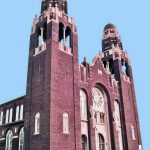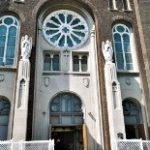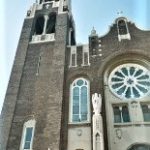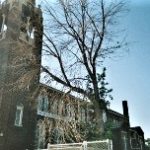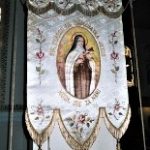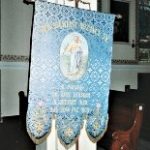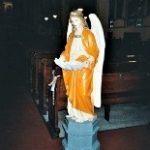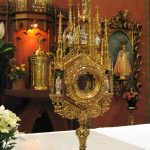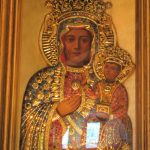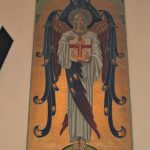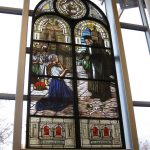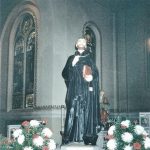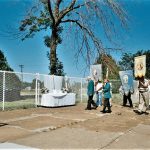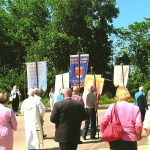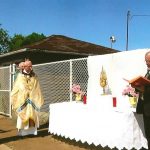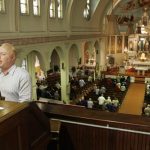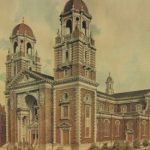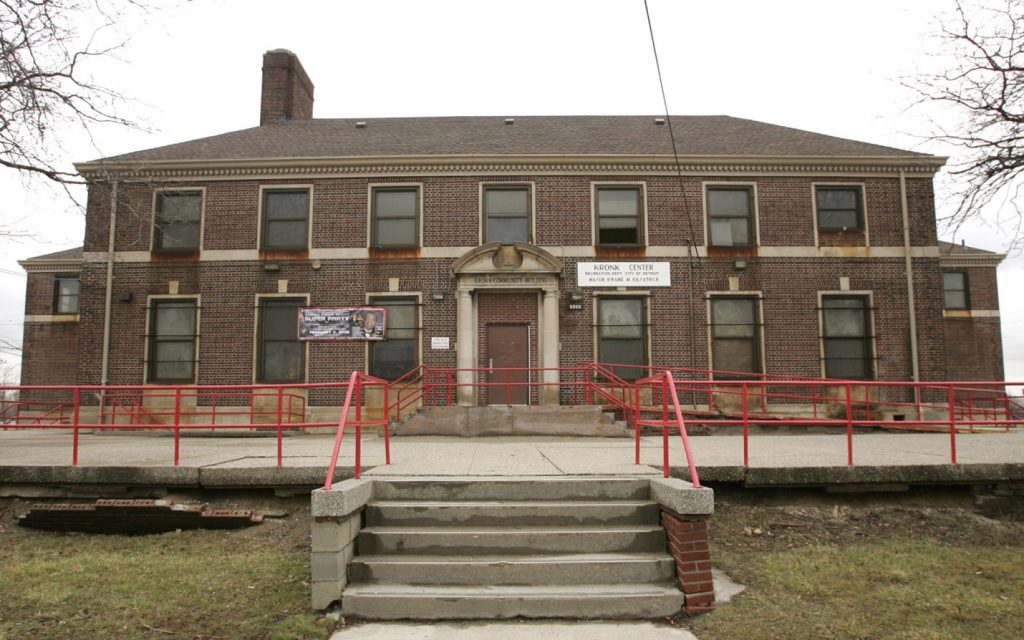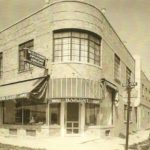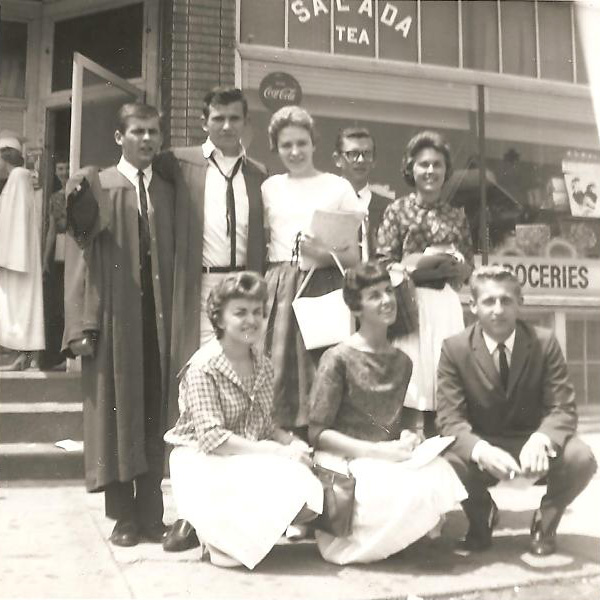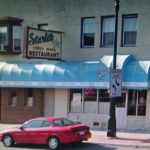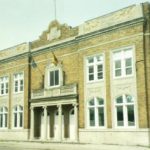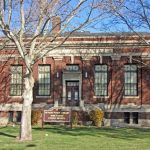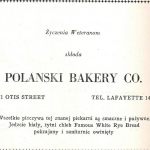Part 1 | Part 2
A Firm and Faithful Fortress:
St. John Cantius Roman Catholic Church
844 Harbaugh Street, Delray 48209: 1902 – 2007
It has been said that on the day we’re born we begin to die. But no one prepares us for the death of a church—when its altar is stripped bare, its doors are chained and bolted shut, and its heart stops beating. For many in Delray, it was St. John Cantius Roman Catholic Church that was the pulse of the community, shallow and weak as it may have been for her last 30-some years. But on October 28, 2007, after 105 years, she gave up her ghost, and a stillness fell over the neighborhood as it, too, seemed to breathe its last breath.
In the days after the church’s closure, heartbreaking scenes that bordered on the horrific unfolded as sacred statues and other artifacts were carried out of the church and placed carefully into the back ends of transport vans and the beds of old pickup trucks to be shipped to other locales, mostly other parishes within the area. Even the stained glass windows were wrenched from their casings and relocated to new homes. Anyone who was even remotely affiliated with the breathtakingly beautiful parish mourned her passing. Some might say that the area and the church’s parishioners are still reeling from the devastating event. With the closure of St. John Cantius parish, the entire Delray community took one more step on its journey of returning to the hills from which it rose and toward becoming a ghost town.
Delray is no stranger to loss. The neighborhood, situated on the southwest side of Detroit with a border on the banks of the Rouge River, is home to what was long ago one of the largest Native American mounds used for the interment of their dead. The mound, which was 40 feet high and several hundred feet long, is believed to have been used by successive tribes. Evidence also suggests that it was used by successive generations of Native Americans, and stories swirl around in Delray yet today of ghosts that inhabit its parts, perhaps due to disturbance of the mound.
The name Delray was derived from the Battle of El Molino del Rey during the Mexican-American War. The neighborhood was in existence since 1836 and was known originally as Belgrade. When Augustus D. Burdeno, an early settler of the area, returned from the war in approximately 1848, he purchased land in what was then Belgrade and convinced other residents to rename the town Del Rey. In 1851, by resident vote, the name was Anglicized to Delray.
Historic Fort Wayne, built in 1843, is one of Delray’s landmarks. The third of Detroit’s forts, it is situated on the far eastern end of the neighborhood at the foot of Livernois Avenue on the banks of the Detroit River. It was constructed to protect Detroit from attack by the British out of Amherstburg, Ontario. No one then could foretell that the real enemy would not be British soldiers or any military regiment but rather the onslaught of sewage, carbon, and other chemical waste and that the area’s topography, particularly Delray’s proximity to the Detroit and Rouge Rivers, provided the perfect components for both triumphant victory and catastrophic defeat.
The small riverfront section of Southwest Detroit known as Delray is encircled by water on three sides in the form of the Detroit River to its southeast and a branch of the Rouge River, which encircles neighboring Zug Island, on its south and west borders. From an aerial view, the Rouge River appears to form the outline of a rosary, its loop of five decades of Mystery beads surrounding Zug Island. Its Glory Be and Hail Mary droplets are the tributary that travels west and crosses W. Jefferson Avenue, ascending to the Our Father at St. Mary’s Cement and culminating in the Sign of the Cross where it intersects the Fisher Freeway.
This symbolism cannot be lost on those Catholics who grew up in Delray and who spent their lives sheltered within the walls of St. John Cantius Church, grounded in their faith.
Salt mining, which dates back to 1870 in Delray, was one of the area’s first industries. Due to its close proximity to the river and also the railroad, which connected Detroit to Toledo, the area soon became a magnet for other large industries, including Michigan Carbon Works, the Solvay Process Company chemical plant, which manufactured sodium carbonate—a chemical used in a variety of cleaning products—as its primary product, and the Detroit Iron and Steel Company. Later, a Detroit Edison power plant, Peerless Portland Cement Company, Allied Chemical, and Fleetwood Metal Body entered the area, along with many smaller companies. The industries drew a flood of immigrants seeking good paying jobs and affordable housing.
Among Delray’s early immigrants were Slovaks, Hungarians, Armenians and Poles. When the Michigan Malleable Iron Company began operating in Delray in 1898, large masses of Hungarians arrived from such cities as Cleveland, South Bend, and Toledo in search of better paying jobs and improved working conditions. Ironmaking was introduced to the area when the Detroit Iron Works commissioned the building of a blast furnace on Zug Island in 1901. A second blast furnace would later be built in 1909 when the works was purchased by the M. A. Hanna Company of Cleveland, resulting in the creation of more jobs. For the most part, the Hungarian and Polish immigrants lived in communities that were separated by a set of railroad tracks that bisected the neighborhood.
But Delray was not known only for its industry. It was a festive place as well, and on September 17, 1889, more than 300,000 enthusiasts poured into the village for the Detroit International Exposition & Fair. For years, city officials had been contemplating an exposition and discussing their desire to create an event that was even grander than the Michigan State Fair. The event’s officers purchased 72 acres of land in Delray, which they decided upon as the site of the exposition. The 10-day event featured manufacturing, mechanical, agricultural, animal and farming exhibits, games, horse riding, yachting competitions, fireworks, and a “balloon ascension specialist” who took to the sky in his hot air balloon. An official exposition building, which resembled a humongous castle, was built specifically for the event at 7501 W. Jefferson Avenue. (It was long ago demolished.) Three more fairs were subsequently held on the site, after which the land was sold to Solvay Process Company.
In the 1800s, Catholic immigrants of Delray worshiped at St. Francis d’Assisi parish, located at 4500 Wesson Street in Detroit, some four miles from Delray, as there was no Catholic church in Delray. Their children attended school at St. Francis School and were taught by the Sisters of St. Francis. St. Francis d’Assisi was built in 1889 and was the fifth Polish parish in Detroit and the second on Detroit’s west side, after St. Casimir. However, the automobile had not yet made its debut, and the Delray parishioners soon became weary of the long commute to St. Francis.
Thirty-eight Polish families soon petitioned Bishop Foley for the founding of a new parish in Delray. Rev. Felix Kieruj, Pastor of St. Francis, and Rev. John Walczak, Vicar, assisted with the process.
But two years went by and there was no sign of a new parish. By then, the families had more than doubled, numbering 90. At Rev. Kieruj’s suggestion, on April 5, 1902, the group of families purchased nine plots of land in an effort to demonstrate their commitment to the building of a new church. After only two weeks, convinced of the parishioners’ determination and sincerity, Bishop Foley approved the establishment of St. John Cantius parish in Delray, named for St. John of Kanty, priest of the diocese of Krakow, Poland. That same year, Rev. John Walczak, who led the effort to build a temporary church and school, was assigned as founding pastor of St. John Cantius. The original church was a wood-framed structure. The schoolhouse had 11 classrooms to accommodate the school’s 107 students, and Felician Sisters arrived to instruct them.
In1904, a Hungarian Lutheran Church was formed in Delray and opened at 8151 Thaddeus Street, and in 1905, Holy Cross Hungarian Roman Catholic Church opened at 8423 South Street. Several more Hungarian churches, including a Hungarian Baptist church and St. John the Baptist Hungary Byzantine Rite Catholic Church, were opened in the area. Because of its large Hungarian population, the Delray-Springwells area became known as “Little Hungary.” Three subsequent waves of Hungarians would arrive in Detroit.
In 1905, the city of Detroit annexed Delray’s seven square miles, along with its neighboring villages of Woodmere and Springwells.
The congregation of St. John Cantius worshiped in the temporary church for several years but soon outgrew it. Well-known architect Harry J. Rill, who had been the architect of other Detroit-area churches, was commissioned to design a newer, larger church at a cost of $51,000. The value in 2020 dollars would be well over $1.3 million. On August 28, 1910, Bishop Kodelka of Cleveland laid the cornerstone of the new church and school.
However, as the parish continued to grow, yet another structure became necessary, and J. G. Steinbach of the Chicago architectural firm of Worthmann & Steinbach was commissioned to design what would become the current and final structure. A parking lot replaced the site where the previous church had stood. Joseph Nowakowski served as the contractor. In 1923, the cornerstone of the impressive red brick church was laid at 844 Harbaugh Street at Thaddeus, west of Dearborn Street and north of W. Jefferson Avenue. The Romanesque-style church featured tall, arched windows, two bell towers, two stone angels placed on either side of the entrance doors and high atop masonry columns, with their arms folded across their chests, and a large, ornate rose window above the doors.
In 1924, St. John Cantius’ daughter parish, Ss. Andrew & Benedict at 2430 S. Beatrice Street in Detroit, just under four miles from St. John Cantius, was born to serve the growing Slovak community.
Bishop Michael J. Gallagher dedicated St. John Cantius Roman Catholic Church on November 15, 1925. Rev. John Walczak served as its first pastor.
In 1929, the completion of the Ambassador Bridge on the east border of the Delray community ensured a constant and regular movement of commercial vehicles in and out of the area. In addition, the Detroit Union Terminal on the corner of Fort Street and Green Street, later named the Detroit Produce Terminal, was built, allowing for more efficient distribution of wholesale crops internationally. By 1930, Delray had grown to approximately 23,000 residents—its highest population in its history—and St. John Cantius School’s enrollment had surged to 1,161 students.
Industry poured into Delray. Streets densely packed with neat little houses and dotted with respectable, family-owned grocery stores, bakeries, meat markets, barber shops, bars and restaurants could be contrasted against factories spewing chemicals into the atmosphere and leaching contaminants into the ground. The population slowly began to diminish as residents moved away from the city in search of housing in less polluted areas. The very industry that drew the residents began to drive them away. Residential real estate values plummeted as rental properties were not adequately maintained. Yet, St. John Cantius continued to serve her faithful, who traveled the distance to attend Mass, Holy Days of obligation, dances and other special parish events.
The year 1939 can be viewed as the beginning of the point of no return for the parish. Although necessary for the city and its residents, the Detroit Wastewater Treatment Plant was an unbelievable assault on the church and its parishioners. The plant was built in conjunction with an expansion of Detroit’s sewer system, which was necessary to serve the city’s growing population and industrialization. The plant was completed in 1939 at a cost of $10 million. Its purpose was to remove and incinerate settled solid waste and then chlorinate the liquid waste before it was discharged into the Detroit River. Fate may simply have placed the divine church in what would become the most undesirable and appalling location imaginable. But despite the stench, scum and sludge closing in on her, the church remained resolute; her parishioners unmoved. Into her doors they continued to be drawn, and out into the world they continued to empty, their spirits lifted and their souls cleansed.
On May 22, 1941, Rev. John Walczak, St. John Cantius’ first resident pastor, died, having served St. John Cantius parish for 39 years. On July 8, 1941, Rev. Vincent Anuszkiewicz was appointed the church’s second pastor.
The next blows to the area came with the construction of the I-75 freeway and the Rouge River Bridge in the 1950s and 1960s and an expansion of the wastewater treatment center in 1957. As the freeway and bridge projects began, the city razed hundreds of houses to make way for the projects’ advancement. Thus, a mass exodus from Delray ensued as residents scattered, fleeing to outlying areas of the city and to the surrounding suburbs, such as River Rouge, Ecorse, Taylor, Melvindale, Lincoln Park, Trenton, Southgate, Allen Park, Dearborn, and Wyandotte. In 1950, enrollment in St. John Cantius School dropped to 309.
Progress once again catapulted the area ahead, providing jobs, infrastructure, connectivity, easier access to roads, and presumably an improved quality of life. But that same progress tore away at and destroyed the modest homes and quiet, simple lives that the salt-of-the-earth, hard-working families of St. John Cantius had known and enjoyed for years.
In 1954, the wastewater treatment center added two new sedimentation tanks to the plant. However, it was evident that additional protection measures needed to be taken in order to safeguard the quality of the river water. In 1957, the center embarked upon a $33 million initiative to improve treatment and to expand the plant’s service area. The invasion of the sewage containers was only beginning.
Unable to survive the declining enrollment, St. John Cantius School succumbed to the inevitable and closed in June of 1969. Parishioners did, however, continue to enjoy the social hall located in the school’s basement.
Additional upgrades were made to the wastewater treatment center in 1970. Polymer and pickle liquor feeding facilities were added and the plant’s chlorination system was improved. The Federal Water Pollution Control Act Amendments of 1972, also known as the Clean Water Act, required secondary treatment of all municipal wastewater. As a result, the plant had to construct aeration tanks, final clarifiers, cryogenic oxygen plants, and additional sludge handling facilities, which translated to more physical encroachment and increased noise levels for the surrounding area.
In 1974, the city bought and razed 300 houses immediately surrounding St. John Cantius parish in an effort to expand the wastewater treatment center. At that time, it was the city’s intent to purchase and raze the church as well. However, St. John Cantius was spared due to the efforts of Detroit City Council members Billy Rogell and Jack Kelley, who fought for the church’s preservation.
A birds-eye view of the treatment plant and the surrounding vicinity is a shocking, mind-numbing spectacle. Wastewater is collected in dozens of enormous, circular, steel sludge thickening drums that stretch out over an expanse of several city blocks to create the largest wastewater treatment plant in the United States. The wastewater collection system and main treatment plant serve more than three million people in 78 communities. The magnitude of the facility is overwhelming, especially when juxtaposed against the solemnity of something as sacred as the church.
Viewed from above, the drums appear as an angry advancing army, overtaking and surrounding St. John Cantius parish on all but one side—her rear façade—which backs up against Copland Street. The drums rise, large and looming, like gigantic lead-footed game pieces, appearing to inch defiantly toward the serene church, whose peaceful countenance is indifferent to the daunting affront. There she stands, regal and composed, a firm and faithful fortress who will neither wield nor waver, a flimsy chain link fence erected at her border bowed in a mocking retort.
And her faithful continued to return to her, ignoring the colossal enemy at her door.
When St. John Cantius celebrated her diamond jubilee in 1977, Rev. Szczygiel stated, “We’ll be a church on an island but the church stays.” (1) The will and determination of the founding parishioners was cemented in the hearts of the faithful, and their fearless leader incorporated and reinforced their resolve.
By 1985, St. John Cantius’ membership had dwindled to 425 families, 75 percent of whom were of Polish descent, reflecting a demographic shift. Many of Detroit’s parishes closed in the late 1980s as a result of a restructuring initiative embarked upon by the Archdiocese. However, St. John Cantius was once again spared. Still, due to worsening pollution and increasing crime, Delray’s residents continued to abandon the area, and by 2000, Delray reached a low point, recording 3,100 residents. Although her parishioners remained devoted, traveling from the suburbs to support the parish, St. John Cantius’ membership had declined to a mere 176 registered families.
Tragically, on October 3, 2006, a fire erupted on the east side of the former school building, destroying the building. The fire was determined to be the result of faulty wiring, and the building was razed the following summer.
The Feast of Corpus Christi, also known as the Solemnity of the Most Holy Body and Blood of Christ, became an annual celebration at St. John Cantius parish that included an outdoor procession. This Roman Catholic feast, held on the Thursday after Trinity Sunday, celebrates the Real Presence of the Body and Blood, Soul and Divinity of Jesus Christ in the elements of the Eucharist. The Corpus Christi procession is an outward demonstration of Catholic faith in which the faithful process through the community with the Blessed Sacrament in a monstrance carried under a decorated canopy. Four special altars are set up and decorated outside the church—usually at the four corners of the church. The priest carries the monstrance and leads the parishioners as they process to each altar, where prayers are said. Hymns are sung along the way.
In a preamble to the closing Mass on October 28, 2007, a final Corpus Christi procession took place at St. John Cantius on Saturday, June 9, 2007.
After the church’s closure, the sacred items within St. John Cantius were disbursed to other parishes and locations throughout the Detroit area as well as throughout the state. The Archdiocese of Detroit oversaw this mission. Many loyal parishioners, past parishioners, and community members also helped to ensure that the sacred objects and artifacts were lovingly preserved.
After the Polish village of Puławy was pillaged at the direction of Catherine of Russia following the third partition of Poland in 1795, Princess Izabela Czartoryska of Poland commanded that the palace be rebuilt. She gathered what was left of the sacred historical heirlooms and royal treasures and placed them in what would become Poland’s first museum. Her Temple of the Sibyl, also called the Temple of Memory, “contained objects of sentimental importance pertaining to the glories and miseries of human life.” (2) She picked up fragments of the destroyed Polish life, including crown jewels, prayer books, and crucifixes, and enshrined them. Her motto became “Przeszłość Przyszłośći” (the Past to the Future).
St. John Cantius fought a battle against an inescapable enemy—progress—an enemy which, ironically, was the necessary lifeblood for her very existence. She was not defeated. Her essence, which is the spirit of her parishioners, lives on victoriously. Her elements live on as well in glorious splendor.
A chandelier now hangs in St. Francis d’Assisi parish. With the help of Sr. Rose Marie Kujawa, CSSF, Ph.D., then-president of Madonna University and a St. John Cantius parishioner from birth, the stained glass window depicting St. John Cantius was refurbished and installed in the Franciscan Center of Madonna University during a special ceremony in 2009. Through her efforts, a statue of St. John Cantius also was relocated to Madonna University.
Daughter parish Ss. Andrew & Benedict received many sacred items, including two gold leaf angel murals, which were installed high upon the walls inside the church.
A statue of St. Anne and Child Mary was relocated to historic Ste. Anne de Detroit.
Sr. Mary Margaret, former principal of St. Edith School in Livonia, was instrumental in overseeing the relocation of a beautiful statue of the Blessed Mother to St. Edith parish.
Two stained glass windows were installed at St. Catherine of Siena Academy in Wixom, while two windows went to St. Paul on the Lake School in Grosse Pointe Farms. One of the windows depicts their patron, St. Paul the Apostle, while another depicts a child with a guardian angel.
More windows were transported to St. Elizabeth Ann Seton Church in Troy.
Two large angel fonts that stood in the entranceway of the church were relocated to Our Lady Queen of Angels parish in Detroit.
Four church bells found a welcoming home and ring anew at St. Paul Tarsus Church in Clinton Township.
Many more sacred items were redistributed to other locations.
Remarkably, St. John Cantius had only four pastors throughout her 105-year history: Rev. John Walczak (1902 – 1941), Rev. Vincent Anuszkiewicz (1941 – 1968); Rev. Edwin Szczygiel (1968 – 2002), and Rev. Edward Zaorski (2002 – 2007).
St. John Cantius Roman Catholic Church was recognized by the West Side Detroit Polish American Historical Society as a historically significant site on April 5, 2008. A framed memorial was presented to Ss. Andrew & Benedict parish, St. John Cantius’ daughter church, at a Mass on October 26, 2008, during Polish Heritage Month, and was installed in the church’s vestibule. As of 2020, Ss. Andrew & Benedict parish remains open, and her diverse congregation consists of Hungarians, Slovaks, Poles, Hispanics, African Americans, Italians, and other nationalities.
In May 2008, Ms. Irene Pilch, who served as secretary of St. John Cantius and who gave countless hours to the parish for decades, was named an Honorary Member of the West Side Detroit Polish American Historical Society.
In June 2020, Mr. Steven Frayer, who served as organist at St. John Cantius for nearly a decade, was named an Honorary Member of the Society.
Several historic items from St. John Cantius were acquired by the West Side Detroit Polish American Historical Society for its archives, including a Polish flag and St. John Cantius banner, as well as several items that were inherited by organist Steven Frayer, which were donated to the archives.
The church building was occupied for a brief time by a Protestant congregation during 2010, but the building has remained abandoned since that time.
It has been said that St. John Cantius Church “in many ways stood at the end of nowhere . . . .” (3) Today, she stands silent and alone at 844 Harbaugh Street, her heart pierced and her body nearly swallowed up by the industrial giant practically encircling her. The windows that used to trap light and reflect it through their vibrant, sacred images no longer reflect her soul. But although she appears lifeless, St. John Cantius Church could as soon be destroyed as eternity itself. Transcending time and humanity, she is as alive as the mighty Kilgen organ that dwelled eight flights up, reigning high within her loft, its bellows full and primed, and which once “absolutely thundered out in celebration of Christ’s triumph over death.” (4)
If you listen closely as you walk the dusty roadside near the ancient interment mounds along the riverbank, as you approach the neighborhood’s burner trains, coke piles and sludge incinerators, you just might hear the strains of an age-old Polish hymn reverberating through the open windows of the vacant church. Maybe it’s the wind, but it could be the sound of your own heart, made whole again in a place that never dies.
- (1) St. John Cantius Church: 1902 – 1977: Diamond Jubilee Pictorial Directory
- (2) https://en.wikipedia.org/wiki/Izabela_Czartoryska
- (3) Frayer, Steve. Email message. (West Bloomfield, MI: September 20, 2020)
- (4) Frayer, Steve. Email message. (West Bloomfield, MI: September 24, 2020)
Sources:
- Frayer, Steve. Email messages. (West Bloomfield, MI: September 20 and 24, 2020)
- Gomulka, Laurie A. “’It Will Rise From the Ashes’: Hamtramck Muralist Dennis Orlowski Breathes New Life into Old Delray.” West Side Detroit Polish American Historical Society e-Newsletter (Volume 55, June 2016)
- Schaldenbrand, Florence. Telephone conversation. (West Bloomfield, MI: September 18, 2020)
- http://www.old-delray.com/LastMassDetNews.htm
- http://www.old-delray.com/HolyCrossHungarianCatholicChurch.htm
- https://www.hourdetroit.com/community/a-fair-to-remember/
- https://en.wikipedia.org/wiki/Delray,_Detroit
- http://skindeep.leadr.msu.edu/immigration-history/a-history-lost/
- https://detroit.curbed.com/2018/5/3/17314922/the-origins-demise-delray
- https://detroitchurchblog.blogspot.com/2017/10/st-john-cantius-parish-history-1902-2007.html
- https://historicdetroit.org/buildings/international-exposition-building
- http://holycrosshungarian.com/
- https://en.wikipedia.org/wiki/Zug_Island
- http://tmwoz.com/johncantius/Homepage_files/StJohnCantiusJubilee1902-1977.pdf
- https://www.water-technology.net/projects/detroit_waste2
- https://en.wikipedia.org/wiki/Fort_Wayne_%28Detroit%29
- https://minermuseum.blogspot.com/2016/03/forgotten-worlds-fairs-detroit-1889.html
- https://digitalcollections.detroitpubliclibrary.org/islandora/object/islandora%3A156576
- https://www.aerial-view.org/
- https://www.freep.com/story/news/columnists/john-carlisle/2017/12/07/delray-neighborhood-detroit-michigan/676597001/
- http://www.old-delray.com/BusinessList.htm
- https://en.wikipedia.org/wiki/Izabela_Czartoryska
- https://www.detroitpolonia.org/st-francis-d-assisi-roman-catholic-church/
Photo Credits:
(Original photo from the Detroit News)
